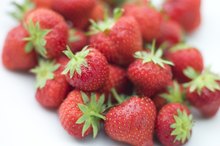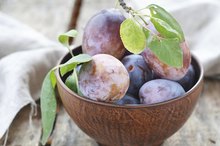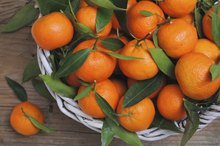Blueberry Allergy Symptoms
Some individuals may experience an allergic reaction to a specific type of food. Symptoms are generally mild. For others, however, reactions can be extreme and sometimes life threatening. Blueberries contain salicylates, which are natural-occurring chemicals in plants. According to Auckland Allergy Clinic, blueberries have high salicylate content. If you are allergic to blueberries, it is often because you have a sensitivity to this compound. If you consume blueberries and experience allergy symptoms, contact a health care professional immediately for treatment.
Angioedema
The National Institutes of Health reports that one common reaction to a food allergy is the swelling of the lips, face, tongue and throat, called angioedema 12. When you are exposed to the blueberries, your body produces immunoglobulin antibodies and histamines which release into your body, causing the characteristic swollen tissue. The welts are usually painful and may or may not be itchy. The deeper the swelling, the more painful the swelling is. Angioedema may disappear on its own after a few hours or after taking over-the-counter antihistamines or anti-inflammatory medication. If other diseases or ailments are present, angioedema may appear, and blueberry consumption may not be the culprit. Consult a physician if symptoms persist or worsen.
- The National Institutes of Health reports that one common reaction to a food allergy is the swelling of the lips, face, tongue and throat, called angioedema 1.
- If other diseases or ailments are present, angioedema may appear, and blueberry consumption may not be the culprit.
Urticaria
Raw Almonds and Swollen Lips
Learn More
According to the Auckland Allergy Clinic, urticaria is usually symptomatic of a salicylate allergy. They emerge on your skin as transient, itchy wheals or red papules known as hives. Generally, individual hive lesions last a mere 24 hours and leave no mark or visual indication of their presence. Persistently eating blueberries or similar berry fruits that contain salicylate can cause chronic urticaria, characterized by long-standing hive rashes for more than six weeks. Several other causes of urticaria are not confined to blueberry consumption. If hives fail to disappear for an extended period of time, contact a physician for evaluation.
- According to the Auckland Allergy Clinic, urticaria is usually symptomatic of a salicylate allergy.
- Persistently eating blueberries or similar berry fruits that contain salicylate can cause chronic urticaria, characterized by long-standing hive rashes for more than six weeks.
Anaphylaxis
If someone has a strong allergic reaction to blueberries, anaphylaxis can develop where extreme constriction of the airways, swelling of the throat, a severe drop in blood pressure and rapid pulse can occur. Often, dizziness, light-headedness and loss of consciousness precede the swelling.
Anaphylaxis is life-threatening and requires immediate medical attention. If swelling in the throat occurs, never wait for symptoms to subside as it can progressively worsen and cut off airflow. Seek emergency care immediately.
- If someone has a strong allergic reaction to blueberries, anaphylaxis can develop where extreme constriction of the airways, swelling of the throat, a severe drop in blood pressure and rapid pulse can occur.
- Anaphylaxis is life-threatening and requires immediate medical attention.
Related Articles
References
- National Institutes of Health: MedlinePlus: Agioedema
- National Institutes of Health: MedlinePlus: Food Allergy
- Blueberries, raw. FoodData Central. U.S Department of Agriculture. Published April 1, 2019.
- Institute of Medicine (US) Panel on Micronutrients. Dietary Reference Intakes for Vitamin A, Vitamin K, Arsenic, Boron, Chromium, Copper, Iodine, Iron, Manganese, Molybdenum, Nickel, Silicon, Vanadium, and Zinc. Washington (DC): National Academies Press (US); 2001. 10, Manganese.
- Krikorian R, Shidler MD, Nash TA, et al. Blueberry supplementation improves memory in older adults. J Agric Food Chem. 2010;58(7):3996-4000. doi:10.1021/jf9029332
- Devore EE, Kang JH, Breteler MM, Grodstein F. Dietary intakes of berries and flavonoids in relation to cognitive decline. Ann Neurol. 2012;72(1):135-43. doi:10.1002/ana.23594
- Cassidy A, Mukamal KJ, Liu L, et al. High anthocyanin intake is associated with a reduced risk of myocardial infarction in young and middle-aged women. Circulation. 2013;127(2):188-96. doi:10.1161/CIRCULATIONAHA.112.122408
- Kimble R, Keane KM, Lodge JK, Howatson G. Dietary intake of anthocyanins and risk of cardiovascular disease: A systematic review and meta-analysis of prospective cohort studies. Crit Rev Food Sci Nutr. 2019;59(18):3032-3043. doi:10.1080/10408398.2018.1509835
- Yousuf B, Gul K, Wani AA, Singh P. Health benefits of anthocyanins and their encapsulation for potential use in food systems: a review. Crit Rev Food Sci Nutr. 2016;56(13):2223-30. doi:10.1080/10408398.2013.805316
- Martineau LC, Couture A, Spoor D, et al. Anti-diabetic properties of the Canadian lowbush blueberry Vaccinium angustifolium Ait. Phytomedicine. 2006;13(9-10):612-23. doi:10.1016/j.phymed.2006.08.005
- Stull AJ, Cash KC, Johnson WD, Champagne CM, Cefalu WT. Bioactives in blueberries improve insulin sensitivity in obese, insulin-resistant men and women. J Nutr. 2010;140(10):1764-8. doi:10.3945/jn.110.125336
- Cunningham E. Are there foods that should be avoided if a patient is sensitive to salicylates?. J Am Diet Assoc. 2010;110(6):976. doi:10.1016/j.jada.2010.04.020
- Rane A, Lindh JD. Pharmacogenetics of anticoagulants. Hum Genomics Proteomics. 2010;2010:754919. doi:10.4061/2010/754919
- Bouzari A, Holstege D, Barrett DM. Mineral, fiber, and total phenolic retention in eight fruits and vegetables: a comparison of refrigerated and frozen storage. J Agric Food Chem. 2015;63(3):951-6. doi:10.1021/jf504890k
Writer Bio
Skyler White is an avid writer and anthropologist who has written for numerous publications. As a writing professional since 2005, White's areas of interests include lifestyle, business, medicine, forensics, animals and green living. She has a Bachelor of Arts in anthropology from San Francisco State University and a Master of Science in forensic science from Pace University.









